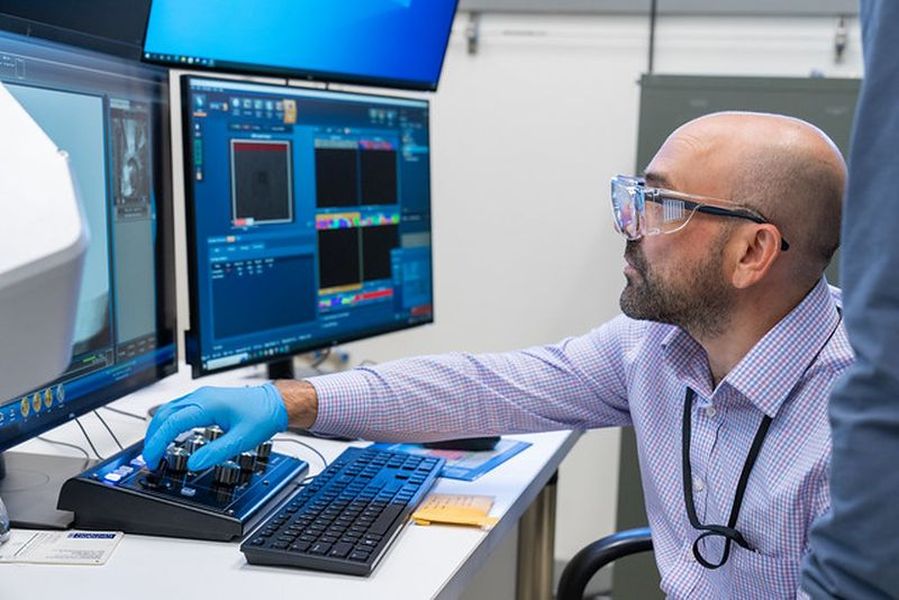In 2021, the United States and 18 other global nations made the pledge to pursue a goal of net-zero carbon emissions by 2050 via launching the Net Zero Government Initiative. It's a lofty goal and that will require dedicated minds from countless areas of special study to become a reality.
Mechanical Engineering senior Chris Slaton's work with superalloys over the summer as a Mickey Leland Energy Program fellow with the U.S. Department of Energy (DOE) and Office of Fossil Energy and Carbon Management (FECM) was one piece of a larger puzzle that seeks to bring us one step closer to reducing our net carbon emissions to zero by the year 2050.
"I really want to get into the energy sector, so I thought this was a perfect opportunity to jump in and do some research with the DOE for the FECM," Slaton said.
Superalloys are complex, high-strength alloys – materials made by combining two or more metallic elements – with an impressive ability to resist both intense stress and extremely high temperatures.
One greener energy option currently under investigation in the United States is the use of hydrogen to generate electricity. Though it burns cleaner than traditional fossil fuels, it also burns much hotter. Existing systems would need to be upgraded with new nickel superalloy components to meet the challenge, and meeting this need is what makes identifying the ideal chemical composition of the right alloy so important.
"In terms of the specific alloy I was investigating, we're really looking for a replacement for turbine rotors. With our current technology, systems often use steam, wind, water or gas to move rotors and thereby generate power,” Slaton said. “These alloys we're investigating are specifically intended for hydrogen turbines. To successfully handle burning hydrogen, they need to be able operate at much higher temperatures, so you need a stronger material to be able to reach and withstand those high temperatures for sustained operations.”
Grain structure – the physical microstructure that gives a superalloy its high-performance characteristics – is something of tiny scale but huge importance. Slaton spent the duration of the summer program using electron microscopy and electron backscatter diffraction to investigate three variations (each containing a slightly different amount of carbon) of Nimonic 105, which is an alloy of particular interest. These tools can provide important clues and additional context that help guide the process of material selection for specific industrial tasks.
Slaton's investigation, however, was only the tip of the iceberg.
"My roommate – the other participant that I stayed with in Oregon – was working on a related project, but more for the pipelines themselves,” Slaton said. “He was investigating coating technologies to help reduce the effects of hydrogen corrosion on the current pipelines, which would allow us to use the pipeline that's already in the ground to move hydrogen.”
Retrofitting existing structures and systems to the fullest extent possible not only further reduces waste and emissions but reduces additional labor and delays that could impede the United States' ability to meet the proposed 2050 deadline.
"I realized that we have all of these projects over at the DOE all focused on achieving one goal, and that is being able to provide clean energy,” he said. “I think the scale at which there's cohesion across the DOE and how they and the FECM bring together all of these projects to focus on their goal of net zero carbon emissions by 2050 is just awe-inspiring."
In August, the program concluded with a forum that allowed participants to present their research work and project findings.
"The Technical Forum at the end of the summer went really well. We got to meet the Secretary of Energy, and we got to speak with a lot of people, and we got to see everybody's projects. Some of them were incredibly technical – that was really impressive. You could really tell how much they focus on bringing in new scientists to the DOE. They put a lot of energy into making sure they get the people they need to move the mission forward," Slaton said.
Having now returned to Texas, Slaton hopes that his knowledge and experience will help him find further research opportunities with a material science lab at the University of Houston.
![Chris Slaton [right], a Mechanical Engineering student at the Cullen College of Engineering, completed the Mickey Leland Energy Program fellowship this summer with the U.S. Department of Energy and Office of Fossil Energy and Carbon Management. Chris Slaton [right], a Mechanical Engineering student at the Cullen College of Engineering, completed the Mickey Leland Energy Program fellowship this summer with the U.S. Department of Energy and Office of Fossil Energy and Carbon Management.](/sites/ccoe.egr.uh.edu/files/images/news/2023/chris-slanton-certificate-01-crop.jpg)
